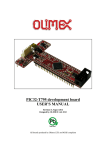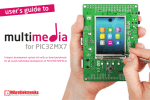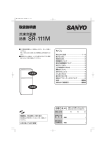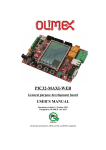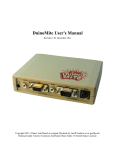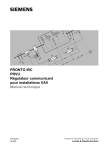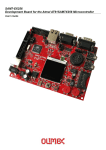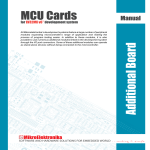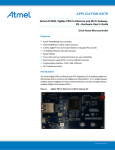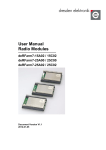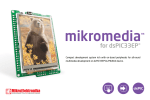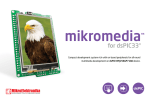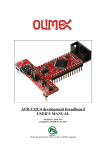Download PIC32-T795 development board USER`S MANUAL
Transcript
PIC32-T795 development board USER’S MANUAL Revision C, February 2013 Designed by OLIMEX Ltd, 2012 All boards produced by Olimex LTD are ROHS compliant OLIMEX© 2012 PIC32-T795 user's manual DISCLAIMER © 2012 Olimex Ltd. Olimex®, logo and combinations thereof, are registered trademarks of Olimex Ltd. Other product names may be trademarks of others and the rights belong to their respective owners. The information in this document is provided in connection with Olimex products. No license, express or implied or otherwise, to any intellectual property right is granted by this document or in connection with the sale of Olimex products. The Hardware project is released under the Creative Commons Attribution-Share Alike 3.0 United States License. You may reproduce it for both your own personal use, and for commertial use. You will have to provide a link to the original creator of the project https://www.olimex.com on any documentation or website. You may also modify the files, but you must then release them as well under the same terms. Credit can be attributed through a link to the creator website: https://www.olimex.com The software is released under GPL. It is possible that the pictures in this manual differ from the latest revision of the board. The product described in this document is subject to continuous development and improvements. All particulars of the product and its use contained in this document are given by OLIMEX in good faith. However all warranties implied or expressed including but not limited to implied warranties of merchantability or fitness for purpose are excluded. This document is intended only to assist the reader in the use of the product. OLIMEX Ltd. shall not be liable for any loss or damage arising from the use of any information in this document or any error or omission in such information or any incorrect use of the product. This evaluation board/kit is intended for use for engineering development, demonstration, or evaluation purposes only and is not considered by OLIMEX to be a finished end-product fit for general consumer use. Persons handling the product must have electronics training and observe good engineering practice standards. As such, the goods being provided are not intended to be complete in terms of required design-, marketing-, and/or manufacturing-related protective considerations, including product safety and environmental measures typically found in end products that incorporate such semiconductor components or circuit boards. Olimex currently deals with a variety of customers for products, and therefore our arrangement with the user is not exclusive. Olimex assumes no liability for applications assistance, customer product design, software performance, or infringement of patents or services described herein. THERE IS NO WARRANTY FOR THE DESIGN MATERIALS AND THE COMPONENTS USED TO CREATE PIC32-T795. THEY ARE CONSIDERED SUITABLE ONLY FOR PIC32-T795. Page 2 of 26 OLIMEX© 2012 PIC32-T795 user's manual Table of Contents DISCLAIMER............................................................................................................. 2 CHAPTER 1 OVERVIEW......................................................................................... 5 1. Introduction to the chapter.......................................................................................................5 1.1 Features.....................................................................................................................................5 1.2 Organization.............................................................................................................................5 CHAPTER 2 SETTING UP THE PIC32-T795 BOARD.........................................7 2. Introduction to the chapter.......................................................................................................7 2.1 Electrostatic warning...............................................................................................................7 2.2 Requirements........................................................................................................................... 7 2.3 Powering the board..................................................................................................................8 2.4 Prebuilt software......................................................................................................................8 CHAPTER 3 PIC32-T795 BOARD DESCRIPTION...............................................9 3. Introduction to the chapter.......................................................................................................9 3.1 Layout (top view).....................................................................................................................9 3.2 Layout (bottom view).............................................................................................................10 CHAPTER 4 THE PIC32MX795F512H MICROCONTROLLER......................11 4. Introduction to the chapter.....................................................................................................11 4.1 The microcontroller...............................................................................................................11 CHAPTER 5 CONTROL CIRCUITY.................................................................... 13 5. Introduction to the chapter.....................................................................................................13 5.1 Reset........................................................................................................................................13 5.2 Clock....................................................................................................................................... 13 CHAPTER 6 HARDWARE......................................................................................14 6. Introduction to the chapter.....................................................................................................14 6.1 ICSP connector...................................................................................................................... 14 6.2 UEXT...................................................................................................................................... 14 6.3 Pinout of the row headers at the bottom..............................................................................15 6.4 USB_OTG...............................................................................................................................16 6.5 Jumper description................................................................................................................17 6.6 Additional hardware components........................................................................................ 18 CHAPTER 7 MEMORY...........................................................................................19 7. Introduction to the chapter.....................................................................................................19 7.1 Block diagram of the processor............................................................................................19 7.2 Memory map.......................................................................................................................... 20 CHAPTER 8 SCHEMATICS...................................................................................21 Page 3 of 26 OLIMEX© 2012 PIC32-T795 user's manual 8. Introduction to the chapter.....................................................................................................21 8.1 Eagle schematic......................................................................................................................21 8.2 Physical dimensions...............................................................................................................23 CHAPTER 9 REVISION HISTORY.......................................................................24 9. Introduction to the chapter.....................................................................................................24 9.1 Document revision................................................................................................................. 24 9.2 Web page of your device....................................................................................................... 25 9.3 Product support..................................................................................................................... 26 Page 4 of 26 OLIMEX© 2013 PIC32-T795 user's manual CHAPTER 1 OVERVIEW 1. Introduction to the chapter Thank you for choosing the PIC32-T795 development board from Olimex! This document provides a User’s Guide for the Olimex PIC32-T795 development board. As an overview, this chapter gives the scope of this document and lists the board’s features. The document’s organization is then detailed. The PIC32-T795 development board enables code development of applications running on the PIC32MX795F512H microcontroller, manufactured by Microchip. 1.1 Features • • • • PIC32MX795F512H 80 Mhz microcontroller 512KB Flash 128KB RAM , 3x SPI, 4x I2C, USB OTG, 1MSPS ADC, PMP 80Mhz digital capture, 5 TIMERS/CCP, 53 GPIOs USB-OTG supporting both Host and Device functions and allows the implementation of Google Android ADK Comes programmed with Duinomite bootloader – even if you lack programmer tool you can program the board using the mini USB UEXT connector which allows many existing modules like RF, ZIGBEE, GSM, GPS to be connected • • two LEDs one BUTTONs • • RESET button mini USB connector is used which is common and used in most cell phones, so you do not have to buy other cables • • all PIC ports available on 0.1" connectors ICSP connector allows programming with PIC-KIT3 • Dimensions 87x54 mm (3.4x2.12") 1.2 Organization Each section in this document covers a separate topic, organized as follow: – Chapter 1 is an overview of the board usage and features – – Chapter 2 provides a guide for quickly setting up the board Chapter 3 contains the general board diagram and layout – Chapter 4 describes the component that is the heart of the board: the PIC32MX795F512H microcontroller Page 5 of 26 OLIMEX© 2013 PIC32-T795 user's manual – Chapter 5 is an explanation of the control circuitry associated with the microcontroller to reset. Also shows the clocks on the board Chapter 6 covers the connector pinout, peripherals and jumper description – – Chapter 7 shows the memory map Chapter 8 provides the schematics – Chapter 9 contains the revision history – Page 6 of 26 OLIMEX© 2013 PIC32-T795 user's manual CHAPTER 2 SETTING UP THE PIC32-T795 BOARD 2. Introduction to the chapter This section helps you set up the PIC32-T795 development board for the first time. Please consider first the electrostatic warning to avoid damaging the board, then discover the hardware and software required to operate the board. The procedure to power up the board is given, and a description of the default board behavior is detailed. 2.1 Electrostatic warning PIC32-T795 is shipped in a protective anti-static package. The board must not be exposed to high electrostatic potentials. A grounding strap or similar protective device should be worn when handling the board. Avoid touching the component pins or any other metallic element. 2.2 Requirements In order to set up the PIC32-T795, the following items are required: - miniUSB to USB A cable - Computer work station Highly recommended items: - Breadboard https://www.olimex.com/Products/Duino/Breadboarding/BREADBOARD-1/, https://www.olimex.com/Products/Duino/Breadboarding/BREADBOARD-MINI/ - PIC32 compatible programmer/debugger. You can use our PIC-KIT3 for programming/debugging https://www.olimex.com/Products/PIC/Programmers/PIC-KIT3/ - Jumper wires for testing https://www.olimex.com/Products/Duino/Breadboarding/BREADBOARD-MINI/ The breadboard helps you use the free pins at the bottom of the board with jumper wires without soldering. Also makes applying external supply easier. Additionally a host-based software toolchain is required in order to program/debug the PIC32-T795 board. Page 7 of 26 OLIMEX© 2013 PIC32-T795 user's manual 2.3 Powering the board The board is powered either by the mini USB or by the SUPPLY1 or SUPPLY2 line(when the board is mounted on the breadboard you might use the VCC and the VDD breadboard bus). On powering the board PWR and LED2 LEDS turn on. The board comes with preloaded Duinomite bootloader. For more information on Duinomite check the following links and documents: http://www.duinomite.com/ https://www.olimex.com/Products/Duino/Duinomite/DUINOMITE-MEGA/ If you don't remove the bootlader the board comes with, when connected via the USB OTG the device should be recognized as a COMx. If it doesn't get recognized this means you lack the driver for your operating system. 2.4 Prebuilt software On arrival the board has a Duinomite bootloader installed. Connect the board to the computer work station (e.g. PC) via the USB OTG. Open the device manager and check which COM port the device initialized at. Launch your favorite terminal program at the COM port found at 115200 baud. Press “Enter” on your keyboard. Write “setup” command in the terminal. For more comprehensive set of example and notes on the MM-Basic check the user manuals of the Duinomite boards. The board can be relatively easy configured for use with Piunguino IDE also. Page 8 of 26 OLIMEX© 2013 PIC32-T795 user's manual CHAPTER 3 PIC32-T795 BOARD DESCRIPTION 3. Introduction to the chapter Here you get acquainted with the main parts of the board. Note the names used on the board differ from the names used to describe them. For the actual names check the PIC32-T795 board itself. 3.1 Layout (top view) The T-shape design is based on idea by Ken Segler (www.KENSEGLERDESIGNS.com). Page 9 of 26 OLIMEX© 2013 PIC32-T795 user's manual 3.2 Layout (bottom view) Page 10 of 26 OLIMEX© 2013 PIC32-T795 user's manual CHAPTER 4 THE PIC32MX795F512H MICROCONTROLLER 4. Introduction to the chapter In this chapter is located the information about the heart of PIC32-T795 – its microcontroller. The information is a modified version of the datasheet provided by its manufacturers. 4.1 The microcontroller PIC32-T795 board uses PIC32MX795F512H from Microchip Technology with these features: High-Performance 32-bit RISC CPU: − MIPS32® M4K® 32-bit core with 5-stage pipeline − 80 MHz maximum frequency − 1.56 DMIPS/MHz (Dhrystone 2.1) performance at zero Wait state Flash access − Single-cycle multiply and high-performance divide unit − MIPS16e™ mode for up to 40% smaller code size − Two sets of 32 core register files (32-bit) to reduce interrupt latency − Prefetch Cache module to speed execution from Flash Microcontroller Features: − Operating voltage range of 2.3V to 3.6V − 512K Flash memory (plus an additional 12 KB of Boot Flash) − 128K SRAM memory − Pin-compatible with most PIC24/dsPIC® DSC devices − Multiple power management modes − Multiple interrupt vectors with individually programmable priority − Fail-Safe Clock Monitor mode − Configurable Watchdog Timer with on-chip Low-Power RC oscillator for reliable operation Peripheral Features: − Atomic SET, CLEAR and INVERT operation on select peripheral registers − 8-channels of hardware DMA with automatic data size detection − USB 2.0-compliant full-speed device and On-The-Go (OTG) controller: − Dedicated DMA channels − 10/100 Mbps Ethernet MAC with MII and RMII interface: − Dedicated DMA channels − CAN module: − 2.0B Active with DeviceNet™ addressing support Page 11 of 26 OLIMEX© 2013 − − − − − − − − − − − − − − − − − − − − − PIC32-T795 user's manual − Dedicated DMA channels 3 MHz to 25 MHz crystal oscillator Internal 8 MHz and 32 kHz oscillators Six UART modules with: − RS-232, RS-485 and LIN 1.2 support − IrDA® with on-chip hardware encoder and decoder Four SPI modules Five I2C™ modules Separate PLLs for CPU and USB clocks Parallel Master and Slave Port (PMP/PSP) with 8-bit and 16-bit data, and up to 16 address lines Hardware Real-Time Clock and Calendar (RTCC) Five 16-bit Timers/Counters (two 16-bit pairs combine to create two 32-bit timers) Five Capture inputs Five Compare/PWM outputs Five external interrupt pins High-speed I/O pins capable of toggling at up to 80 MHz High-current sink/source (18 mA/18 mA) on all I/O pins Configurable open-drain output on digital I/O pins Debug Features: Two programming and debugging Interfaces: − 2-wire interface with unintrusive access and real-time data exchange with application − 4-wire MIPS® standard enhanced Joint Test Action Group (JTAG) interface Unintrusive hardware-based instruction trace IEEE Standard 1149.2 compatible (JTAG) boundary scan Analogue Features: 16-channel, 10-bit Analog-to-Digital Converter: − 1 Msps conversion rate − Conversion available during Sleep and Idle Two Analog Comparators 5V tolerant input pins (digital pins only) Page 12 of 26 OLIMEX© 2013 PIC32-T795 user's manual CHAPTER 5 CONTROL CIRCUITY 5. Introduction to the chapter Here you can find information about reset circuit and quartz crystal locations. 5.1 Reset PIC32-T795 reset circuit includes R13 (4.7 kΩ), R14 (330 Ω), R66(560 Ω), C21(100 nF), D3 (1N4148), PIC32MX795F512H pin 7 (#MCLR) and a RESET button. The RESET is also connected to the ICSP pin 1. 5.2 Clock 8 MHz quartz crystal Q1 is connected to pins 39 and 40 of the processor. Real time clock (RTC) Q2 is found at pins 47 and 48 of the processor. Page 13 of 26 OLIMEX© 2013 PIC32-T795 user's manual CHAPTER 6 HARDWARE 6. Introduction to the chapter In this chapter are presented the connectors that can be found on the board all together with their pinout. Jumpers functions are described. Notes and info on specific peripherals are presented. Notes regarding the interfaces are given. 6.1 ICSP connector Note that the ICSP connector mounted on the board is the one with the the larger step – 100 mil. ICSP connector Pin # Signal Name Pin # Signal Name 1 RESET 4 PGED1 2 +3.3 5 PGEC1 3 GND 6 Not connected 6.2 UEXT PIC32-T795 board has UEXT connector and can interface Olimex's UEXT modules. For more information on UEXT please visit: https://www.olimex.com/Products/Modules/UEXT Pin # Signal Name 1 +3.3V 2 GND 3 U2TX 4 U2RX 5 SCL1 6 SDA1 Page 14 of 26 OLIMEX© 2013 7 MISO 8 MOSI 9 SCK 10 #CS PIC32-T795 user's manual 6.3 Pinout of the row headers at the bottom For your convenience the pads are named individually near each of them. Please take extra care about the numbering but consider that there might be offset. PIN# MCU Pin # – Port Name (Used for) PIN# MCU Pin # - Port Name (Used for) 1 13 - RB3 25 46 – RD0 (PINGUINO_BOOT) 2 12 - RB4 26 52 - RD4 3 17 – RB6 27 53 - RD5 4 18 – RB7 28 54 - RD6 5 22 – RB9 29 55 - RD7 6 23 – RB10 30 58 - RF0 7 45 - RD11 31 59 - RF1 8 51 – RD3 (MOSI) 32 32 – RF5 (U2TX) 9 50 – RD2 (UEXT) 33 31 – RF4 (U2RX) 10 49 – RD1 (SCK) 34 21 - RB8 11 60 – RE0 35 29 - RB14 12 61 - RE1 36 28 - RB13 13 62 - RE2 37 30 – RB15 (LED1) 14 63 - RE3 38 4 - RG6 15 64 - RE4 39 5 – RG7 (USB_FAULT) 16 1 - RE5 40 6 - RG8 17 2 - RE6 41 8 - RG9 18 3 - RE7 42 11 – RB5 (VBUSON) 19 24 – RB11 (#CS) 43 14 - RB2 Page 15 of 26 OLIMEX© 2013 PIC32-T795 user's manual 20 27 – RB12 (LED2) 44 15 – RB1 (PGEC1) 21 33 – RF3 (USB_ID) 45 16 – RB0 (PGED1) 22 42 – RD8 (DUINOMITE_BOOT) 3.3V 3.3V 23 43 – RD9 (SDA1) GND 24 44 – RD10 (SCL1) +5V_ +5V EXT GND 6.4 USB_OTG USB-OTG can act makes possible to USB devices to the board. It makes the board act either as USB device or USB host. Pin # Signal Name 1 VBUS 2 D- 3 D+ 4 USB_ID 5 GND Page 16 of 26 OLIMEX© 2013 PIC32-T795 user's manual 6.5 Jumper description Most of the jumper configurations are printed with white print on the PCB for your convenience. Note that all of the jumpers on the board are SMD type. You will need basic soldering skills to be able to close those jumpers. If you have to separate already connected ones unsolder them and if needed cut the wire between the pads with cutter knife. 5V_E Those 4 jumpers control whether the LEDs are powered (closed) or not (open). Default state is closed. RD8/RD0 Changes the default boot pin. If RD8 is selected starts with Duinomite bootloader. If RD0 is selected Pinguino bootloader. The difference between the two bootloaders is the processor pin used for the button. Default positions is RD8. EE_SCL1_E & EE_SDA1_E These jumpers must be moved together. When open disconnect the EEPROM. If you use UEXT connector for something different than I2C better cut both these jumpers. Default state is closed. Page 17 of 26 OLIMEX© 2013 PIC32-T795 user's manual 6.6 Additional hardware components The components below are mounted on PIC32-T795 but are not discussed above. They are listed here for completeness: user button + RST button 2 user LEDs + PWR LED Page 18 of 26 OLIMEX© 2013 PIC32-T795 user's manual CHAPTER 7 MEMORY 7. Introduction to the chapter On the next page you can find a memory map for this family of processors. It is strongly recommended to refer to the original datasheet released by Microchip for one of a higher quality. 7.1 Block diagram of the processor Page 19 of 26 OLIMEX© 2013 PIC32-T795 user's manual 7.2 Memory map Page 20 of 26 OLIMEX© 2013 PIC32-T795 user's manual CHAPTER 8 SCHEMATICS 8. Introduction to the chapter In this chapter are located the schematics describing logically and physically PIC32-T795. 8.1 Eagle schematic PIC32-T795 schematic is visible for reference here. You can also find them on the web page for PIC32-T795 at our site: https://www.olimex.com/Products/Duino/PIC32/PIC32-T795/. They are located in HARDWARE section. The EAGLE schematic is situated on the next page for quicker reference. Page 21 of 26 OLIMEX© 2012 PIC32-T795 User's Manual USB-OTG +5V +5V_EXT ICSP U1 3.3V_AVCC 3.3V 7 RESET 1.8V_CORE 56 10uF/6.3V 10k 10k 57 38 26 10 19 R1 R2 C1 C2 C3 100nF 100nF 100nF C4 C5 20 9 25 41 USB_FAULT U2 7 1 2 3 IN #EN #FLG GND MIC2075YM T1 Q1 C8 27pF Q8.000MHz/20pF C9 27pF C10 27pF GN D 10k 47 k GND2 GND1 VBUS DD+ USB_ID USB GND4 GND3 3.3V DTC114YKA VBUS DD+ ID GND 60 61 62 63 64 1 2 3 11 12 13 14 15 16 17 18 Q2 QCT 32768(2x6)/6pF VBUSON USB 39 40 48 47 GND GND C11 OUT OUT NC NC 100nF 8 6 5 4 35 34 36 37 VBUS DD+ C15 10nF C12 C13 100nF 2.2uF 38 39 40 41 C14 100nF USB-OTG PGED1/AN0/VREF+/CVREF+/PMA6/CN2/RB0 PGEC1/AN1/VREF-/CVREF-/CN3/RB1 AN2/C2IN-/CN4/RB2 AN3/C2IN+/CN5/RB3 AN4/C1IN-/CN6/RB4 AN5/C1IN+/VBUSON/CN7/RB5 PGEC2/AN6/OCFA/RB6 PGED2/AN7/RB7 AN8/C2TX/#SS4/U5RX/#U2CTS/C1OUT/RB8 AN9/C2OUT/PMA7/RB9 TMS/AN10/CVREFOUT/PMA13/RB10 TDO/AN11/PMA12/RB11 TCK/AN12/PMA11/RB12 TDI/AN13/PMA10/RB13 AN14/C2RX/SCK4/U5TX/#U2RTS/PMALH/PMA1/RB14 AN15/EMDC/AEMDC/OCFB/PMALL/PMA0/CN12/RB15 C6 100nF 100nF C7 27pF #MCLR VCAP/VCORE VDD VDD VDD VDD = Pins are up to 5V tolerant AVDD 4 5 6 8 USB_FAULT AVSS VSS VSS VSS OSC1/CLKI/RC12 OSC2/CLKO/RC15 SOSCO/T1CK/CN0/RC14 SOSCI/CN1/RC13 OC1/INT0/RD0 EMDIO/AEMDIO/SCK3/U4TX/#U1RTS/OC2/RD1 SDA3/SDI3/U1RX/OC3/RD2 SCL3/SDO3/U1TX/OC4/RD3 OC5/IC5/PMWR/CN13/RD4 PMRD/CN14/RD5 AETXEN/ETXERR/CN15/RD6 ETXCLK/AERXERR/CN16/RD7 RTCC/AERXD1/ETXD3/IC1/INT1/RD8 AERXD0/ETXD2/#SS3/U4RX/#U1CTS/SDA1/IC2/INT2/RD9 ECOL/AECRSDV/SCL1/IC3/PMCS2/PMA15/INT3/RD10 ECRS/AEREFCLK/IC4/PMCS1/PMA14/INT4/RD11 ERXD1/PMD0/RE0 ERXD0/PMD1/RE1 ERXDV/ECRSDV/PMD2/RE2 ERXCLK/EREFCLK/PMD3/RE3 ERXERR/PMD4/RE4 ETXEN/PMD5/RE5 ETXD0/PMD6/RE6 ETXD1/PMD7/RE7 VUSB VBUS D-/RG3 D+/RG2 SCK2/U6TX/#U3RTS/PMA5/CN8/RG6 SDA4/SDI2/U3RX/PMA4/CN9/RG7 SCL4/SDO2/U3TX/PMA3/CN10/RG8 #SS2/U6RX/#U3CTS/PMA2/CN11/RG9 C1RX/AETXD1/ERXD3/RF0 C1TX/AETXD0/ERXD2/RF1 USBID/RF3 AC1TX/SDA5/SDI4/U2RX/PMA9/CN17/RF4 AC1RX/SCL5/SDO4/U2TX/PMA8/CN18/RF5 PGED1 PGEC1 16 15 14 13 12 11 17 18 21 22 23 24 27 28 29 30 45 44 43 1 2 42 3 4 34 5 6 19 20 36 35 37 VBUSON #CS LED2 LED1 46 PINGUINO_BOOT 49 SCK 50 MISO 51 MOSI 52 53 54 55 42 DUINOMIT E_BOOT 43 SDA1 44 SCL1 45 58 59 33 31 32 USB_ID U2RX U2TX 3.3V R3 RESET ICSP 1 2 3 4 5 6 33R PGED1 PGEC1 CON6WF6S UEXT 25 10 9 8 26 27 28 29 22 23 24 7 3.3V 3.3V R4 4.7k UEXT U2TX SCL1 MISO SCK 30 31 21 33 32 3.3V 3.3V 1 3 5 7 9 2 4 6 8 10 R5 4.7k R6 10k U2RX SDA1 MOSI #CS BH10S PIC32MX795F512H-80I/PT 3.3V PIC32-T795H Rev.B Designed by: W WW.OLIMEX.COM/DEV BASED ON W WW .KENSEGLERDESIGNS.COM IDEA Released under Creative Commons Attribution-Share Alike 3.0 United States License POWER SUPPLY 1 2 C16 10nF EEPROM 3.3V 3.3V 3.3V R9 100k/1% STAT LEDS 3.3V LED1 0R 0R(NA) R14 330R DUINOMITE_BOOT close LED2 6 SCL 7 WP 3 A2 2 A1 1 A0 VCC 24LC256-I/SN Page 22 of 26 R20 1k R21 1k LED1 LED0603/GREEN LED2 LED0603/YELLOW 8 U3 EEPROM Array C22 100nF R16 330R EE_SCL1_E 2 SCL1 1 R19 NA(4.7k) SDA GND 4 2 3 BUT C21 4.7nF R17 330R 1 R15 4.7k RESET RST R18 NA(4.7k) PINGUINO_BOOT D3 1N4148/mi ni-melf T1107A(6x3.8x2.5mm) R12 R13 4.7k T1107A(6x3.8x2.5mm) C20 100nF R22 1k 10uF/6.3V 22uH/10%/5m A 3.3V C18 390R/1% R10 R8 1M/1% R7 330R L1 C19 C17 10uF/6.3V AVCC 3.3V OUT ADJ/GND R11 240R/1% GND BUTTONS 10uF/6.3V IN 1N5819S/SS14 +5V_EXT HN1x2 VR1(3.3V) LM1117IMPX-ADJ PWR +5V D2 1 2 open D1 +5V_EXT SUPPLY1 SUPPLY2 3.3V 3.3V 2 HN1x2 1 RD8/RD0 5V_E 1N5819S/SS14 LED0603/RED +5V VBUS LED1 5 EE_SDA1_E 1 2 SDA1 close OLIMEX© 2013 PIC32-T795 user's manual 8.2 Physical dimensions Note that all dimensions are in inches. Page 23 of 26 OLIMEX© 2013 PIC32-T795 user's manual CHAPTER 9 REVISION HISTORY 9. Introduction to the chapter In this chapter you will find the current and the previous version of the document you are reading. Also the web-page for your device is listed. Be sure to check it after a purchase for the latest available updates and examples. 9.1 Document revision Revision A Changes Initial Creation Modified Pages All Improved the document formatting Fixed error about RD8/RD0 jumper B Added info on how to switch between Pinguino and Duinomite mode All Added links to the index Updated links Fixed an error about pin #8 on page 15 C All Updated links Page 24 of 26 OLIMEX© 2013 PIC32-T795 user's manual 9.2 Web page of your device The web page you can visit for more info on your device is https://www.olimex.com/Products/Duino/PIC32/PIC32-T795/. There you can find more info and some examples. ORDER CODES: PIC32-T795 - completely assembled and tested USB-MINI-CABLE - USBmini to USB-A cable PIC-KIT3 - for custom programming/debugging How to order? You can order directly using our web shop or via any of our distributors. The list of distributors is available here: https://www.olimex.com/Distributors/. Check our webpage https://www.olimex.com/ for more info. Page 25 of 26 OLIMEX© 2013 PIC32-T795 user's manual 9.3 Product support For product support, hardware information and error reports mail to: [email protected]. Note that we are primarily a hardware company and our software support is limited. Please consider reading the paragraph below about the warranty of Olimex products. Warranty and returns: Our boards have lifetime warranty against manufacturing defects and components. During development work it is not unlikely that you can burn your programmer or development board. This is normal, we also do development work and we have damaged A LOT of programmers and boards during our daily job so we know how it works. If our board/programmer has worked fine then stopped, please check if you didn't apply over voltage by mistake, or shorted something in your target board where the programmer was connected etc. Sometimes boards might get damaged by ESD shock voltage or if you spill coffee on them during your work when they are powered. Please note that warrany do not cover problems caused by unproper use, shorts, over-voltages, ESD shock etc. If the board has warranty label it should be not broken. Broken labels void the warranty, same applies for boards modified by the customer, for instance soldering additional components or removing components - such boards will be not be a subject of our warranty. If you are positive that the problem is due to manufacturing defect or component you can return the board back to us for inspection. When we receive the board we will check and if the problem is caused due to our fault and we will repair/replace the faulty hardware free of charge, otherwise we can quote price of the repair. Note that all shippings back and forth have to be covered by the customer. Before you ship anything back you need to ask for RMA. When you ship back please attach to it your shipping address, phone, e-mail, RMA# and brief description of the problem. All boards should be sent back in antistatic package and well packed to prevent damages during the transport. Page 26 of 26


























